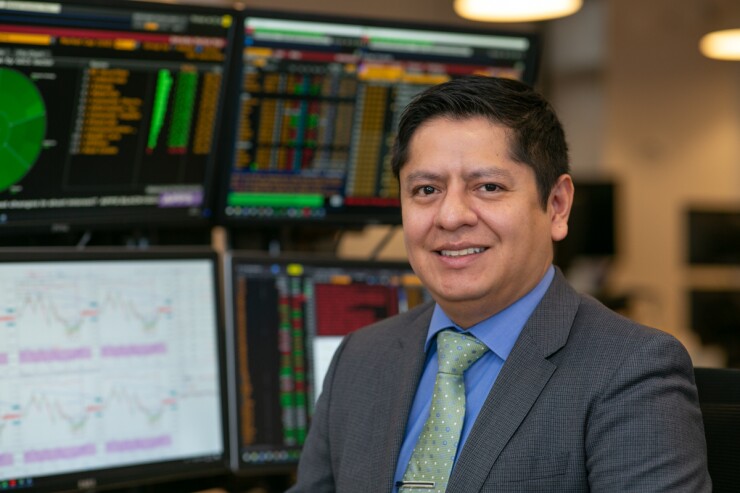It’s a foregone conclusion the Federal Open Market Committee won’t raise the fed funds target rate at its Sept. 19-20 meeting, so the market will concentrate on the updated Summary of Economic Projections and Chair Jerome Powell’s press conference.
“The Fed will try to deliver a hawkish hold on September 20, also driving home the message that interest rates will stay higher for longer,” said Edward Moya, senior market analyst at OANDA.
With the risk of a reacceleration of inflation in the final three months of the year, expect “most officials to still price in one more Fed rate hike,” he added. “The labor market slowdown is coming, but the Fed might need to lower their expectations on how quickly the unemployment rate will rise.”
Inflation projections “will likely show upward pressures have reemerged over the short-term,” Moya noted, although he expects the panel will predict steady declines in 2024 and 2025.
In a note, Morgan Stanley Chief U.S. Economist Ellen Zentner and others see a “downward drift in the 2023 dots,” but not to the point where the median falls 25 basis points. “We expect little change elsewhere in the SEP, and newly introduced 2026 projections to show convergence to neutral.”
It would be “a dovish surprise” should the Fed acknowledge inflation and jobs data have softened or if it “removes the word ‘highly’ from the statement.”
But José Torres, senior economist at Interactive Brokers, thinks the Fed may surprise investors by increasing inflation and GDP projections while keeping jobless rate expectations.
“While the Fed is likely to leave the terminal rate forecast unchanged, signaling one more hike in November, it’s likely to adjust the federal funds rate outlook for 2024 and 2025 upwards closer to 5% and 4%, from 4.6% and 3.4%,” he said. “As the committee waits for the long and variable lags of monetary policy to effectively slow the economy and the labor market, while hopefully battering inflation, its members are reminded of the significant geopolitical risks, including energy supply, within [the latest] CPI [report] that can cloud the inflationary landscape.”
He added, “If energy prices continue their upward trajectory against the backdrop of constrained supply, it won’t be long until that boost is reflected more materially in the core categories of inflation and not just in headline results.”
For Gary Pzegeo, head of fixed income at CIBC Private Wealth U.S., the key to the SEP projections is whether the Fed signals another 2023 rate increase.
“We think the majority of Fed officials will want to have the option of hiking in either November or December and the dot will likely remain in place,” he said. “The June projection was founded on faster projections for growth and core inflation than previous estimates. If anything, the growth story is more robust since June. Core inflation has decelerated but is not slow enough to justify a lower projection by the end of 2023.”

Joanne Smith
While the recent CPI report won’t stop the Fed from a pass at this meeting, Greg Wilensky, head of U.S. fixed income at Janus Henderson Investors, said, “the slightly stronger number can influence the tone of the press conference and Summary of Economic Projections.”
Janus expects fewer participants seeing more increases, “but probably not enough to move the median projection of one more rate hike.” But they believe the Fed is done raising rates.
“Nominal and real GDP forecasts for Q3 are running pretty strong right now — with that clear break from the slowing trend we’ve seen going back to late 2021, there may be pressure from some committee members to avoid any implicit promise that there will be only one more hike in November,” said Peter Ireland, an economics professor at Boston College and a member of the Shadow Open Market Committee, an independent organization that monitors and critiques the FOMC.
But, he added, he’s looking at the 2026 projections, which will be available for the first time. If the panel sees “core PCE inflation returning to levels near 2% in 2025 and staying there in 2026,” which he assumes they will, “that will be reassuring.”
Also of interest are rate projections and whether the FOMC still projects a peak this year, Ireland said. “I suspect that that general tendency will still be there.”
However, he added, “In light of the strong data we’ve had lately, I would not be surprised to see a couple more of the funds rate dots for 2024 and 2025 to move higher, indicating the need to keep interest rates closer to this year’s peak for longer.”
But the recent CPI concerns Jeffrey Cleveland, chief economist at Payden & Rygel, who notes the August read on core suggests an annual rate near 4%, “well above the Fed’s target and a worrisome trend if that’s where we settle in.”
Additionally, shelter prices softened, and “even with relief on the shelter front we’re still seeing sticky inflation,” Cleveland said. “We’ve seen this pattern a few times in the last 18 months where investors say, ‘well as soon as goods prices slow, inflation won’t be a problem’ ‘as soon as rents slow, inflation won’t be a problem,’ etc., but 0.3% is too fast a rate of change.”
As a result, he said, “it’s too early to say the Fed is done even if they skip” at the September meeting. Cleveland doesn’t expect rate cuts “if a 0.3% monthly trend persists.”
Based on recent remarks by FOMC members, Steven L. Skancke, chief economic adviser at Keel Point and former White House and Treasury Department staff member, said “we expect the September SEP will show no further rate increases for the remainder of this year. Fed Chair Powell will qualify this in his remarks, however, by saying rate hikes can resume if needed.”

Projections for GDP will likely be increased, he said. “With robust consumer spending, and GDP still showing steady 2% growth through the rest of the year, the SEP likely will show stronger GDP growth in the third and fourth quarter of this year than in the June SEP.”
With core PCE inflation trending below the June projection, Skancke said, “there may also be a downward revision in the September SEP to third and fourth quarter inflation estimates.”
“The Fed will most likely keep the well-known hawkish, higher-for-longer guidance in play,” according to Christian Scherrmann, U.S. Economist at DWS Group. “If energy prices continue to rise for longer, emerging pressures on core inflation could eventually feed into the Fed’s data-dependent reaction function going forward.”
The SEP changes may have a hawkish bias, he added. “Noteworthy changes to the 2023 growth number are likely — just as we have seen in the Wall Street consensus forecasts.”
The panel is likely “to talk up a soft-landing scenario,” and make no “material change in the likely path of the federal funds rate, leaving the door open for another hike this year if incoming data warrants it.”
Powell is likely “to reiterate the narrative that the current stance of monetary policy may be sufficiently restrictive and that, given the longer-than-expected lags in monetary policy, higher rates may be needed for longer to put inflation on a sustainable path towards the 2% target,” Scherrmann said.
Upside risks to inflation will also be highlighted, he added. “This is likely to keep market expectations high for another rate hike at the November meeting. We, on the other hand, do not expect the Fed to hike further and expect the first downside adjustment in Q2 2024.”
